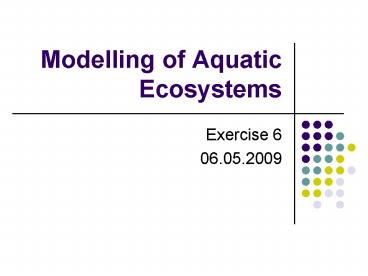Modelling of Aquatic Ecosystems - PowerPoint PPT Presentation
1 / 11
Title:
Modelling of Aquatic Ecosystems
Description:
Calculation of stoichiometric coefficients for all substances j of process i ... constant values of benthic algae biomass (SALG (D.ALG)) and of sedimented ... – PowerPoint PPT presentation
Number of Views:26
Avg rating:3.0/5.0
Title: Modelling of Aquatic Ecosystems
1
Modelling of Aquatic Ecosystems
- Exercise 6
- 06.05.2009
2
Exercise 5 additional constraints
- Calculation of stoichiometric coefficients for
all substances j of process i with the help of k
additional constraints - Example ALG death exercise 5
- constraints list (c ( "C.ALG"
paramY.ALG.death, - "C.POMD" 1,
- "C.POMI" 1)
- (-1)YALG,death ((1-fi)YALG,death) 1
(fiYALG,death)1 0
3
Model exercise 6.1
4
Model exercise 6.1
5
Model exercise 6.1
- State variables
- phosphate (C.HPO4),
- O2 (C.O2),
- ammonium (C.NH4),
- nitrate (C.NO3), nitrite (C.NO2)
- constant values of benthic algae biomass (SALG
(D.ALG)) and of sedimented organic particles
(SPOM (D.POM)) - Considered processes
- growth of SALG on HPO4 and NH4 resp. NO3,
- respiration of SALG
- first (NH4 to NO2) and second (NO2 to NO3) step
of nitrification, - oxic mineralization of SPOM
- Considered interface fluxes
- oxygen exchange with the atmosphere,
- advection between the three river reaches
6
Exercise 6.3 Identifiability
- Change in oxygen concentration due to change in
oxygen exchange coefficient can be compensated by
a change in the ALG and POM density - ? Kinetic parameters of primary production and
ecosystem respiration (mineralization, etc.) are
not identifiable from oxygen concentration data
if oxygen exchange coefficient is unknown
7
Exercise 6.4 Simplifying assumptions
- Prismatic river reach, constant friction, wide
rectangular river bed - Constant flow velocity v in time and across river
cross-section - Constant vertical turbulent diffusion coefficient
Kz - Constant lateral diffusion and dispersion
coefficient ey - Vertical mixing substance enters the river
homogeneously spread over the river width,
lateral dimension and time dependence can be
omitted - Lateral mixing substance enters the river well
mixed over the river depth, vertical dimension
and time dependence can be ignored
8
Exercise 6.4 Vertical/lateral mixing distance
- Vegetation in summer decreases flow velocity (v)
and increases water depth (h) and vertical
turbulent diffusion (Kz) - higher Kz is partially compensated by difference
in water depth resulting in similar vertical
mixing distances (smix,z) - For deeper rivers the coefficient of lateral
turbulent diffusion and dispersion (ey) is higher - Higher ey causes a smaller lateral mixing
distance - Vertical mixing is much faster than lateral
because the width of the river is much larger
than the depth
9
Exercise 6.4 Longitudinal dispersion
- Significantly larger lateral mixing in summer
reduces longitudinal dispersion - Dispersion increases with increasing velocity
differences across the river - Dispersion increases with increasing width of the
river, because of decreasing lateral mixing - Dispersion decreases with lateral turbulent
diffusivity (u h), as this increases mixing
across the river
10
Exercise 6.4 Numerical dispersion
- To avoid numerical dispersion being larger than
longitudinal dispersion the length of the
modelled river sections (mixed reactors) must
fulfill - ?x ltlt Ex 2wh / Q Ex 2 / v
11
Exercise 6.4 Tracer experiment
- Mass of dye tracer needed for experiment, so that
it fulfills Cmax m/hw 1/2v2Ext - with Cmax 0.4 g/m3 and t 600 s































